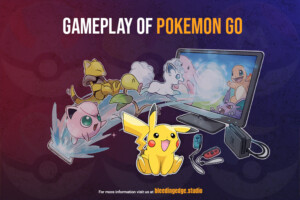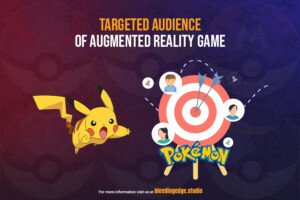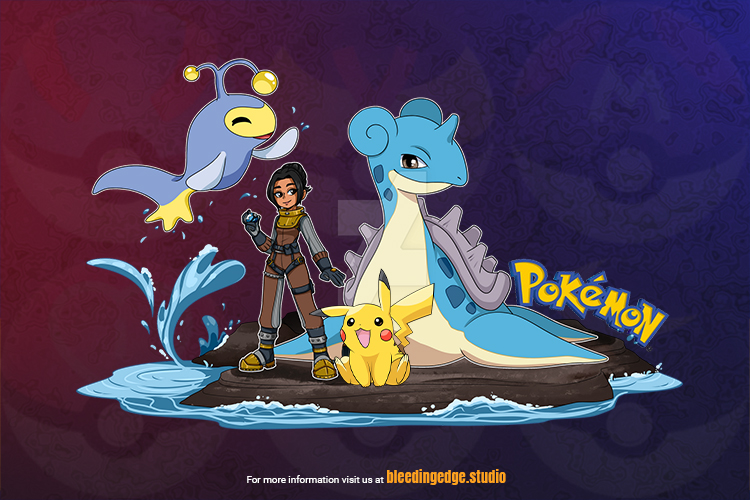Introduction
In mobile gaming, few titles have left as lasting an impact as Pokémon Go. Niantic’s augmented reality masterpiece took the world by storm upon its release in 2016, revolutionizing how people interact with their surroundings and bringing the beloved Pokémon franchise to life in unprecedented ways. This article’ll delve into a comprehensive review of Pokémon Go, examining its key features, success factors, and the mesmerizing blend of augmented reality and gaming. Additionally, we’ll explore the theoretical process of creating a similar game, envisioning the steps BleedingEdge Studio might take to craft its augmented reality experience.

Pokémon Go: A Game-Changer in Augmented Reality
Pokémon Go introduced a groundbreaking concept, integrating augmented reality (AR) into the gaming experience. The game invites players to explore the real world, using their smartphones to discover and capture virtual Pokémon scattered throughout their surroundings. The genius lies in the fusion of digital and physical realms, encouraging players to venture outside, socialize, and engage with their environment in ways that traditional gaming never achieved.
Key Features of Pokémon Go
- Augmented Reality Exploration: The hallmark of Pokémon Go is its use of augmented reality to immerse players in a world where Pokémon coexists with everyday life. The game leverages the device’s camera to overlay Pokémon onto the real-world environment, creating a captivating and interactive experience.
- Real-World Exploration and Social Interaction: Unlike conventional games that confine players to a virtual realm, Pokémon Go encourages outdoor exploration. PokéStops and Gyms are strategically placed at notable landmarks, fostering social interaction as players converge to collect items, battle, and collaborate.
- Catching Pokémon: The core gameplay involves locating and capturing Pokémon. The game cleverly utilizes the device’s GPS to determine a player’s location, spawning Pokémon in various habitats corresponding to the real world—water Pokémon near bodies of water, for example.
- Gym Battles and Team Valor, Mystic, and Instinct: Players choose from three teams—Valor, Mystic, or Instinct—and engage in gym battles to claim territory for their group. This competitive aspect adds depth and a sense of community as players collaborate with teammates to conquer rival gyms.

Success Factors of Pokémon Go
- Nostalgia and Franchise Appeal: Pokémon Go capitalizes on the nostalgic appeal of the Pokémon franchise, leveraging the emotional connection many players have with these iconic creatures. The game successfully taps into the deep well of affection for Pokémon, drawing both veteran fans and newcomers alike.
- Accessibility and Inclusivity: The simplicity of Pokémon Go’s mechanics makes it accessible to players of all ages and gaming backgrounds. The game’s inclusive design encourages people from diverse demographics to participate, contributing to its widespread popularity.
- Social Integration: Pokémon Go is not just a solo gaming experience; it fosters social interaction. Whether cooperating to defeat mighty raid bosses or engaging in friendly rivalries at gyms, the game builds a sense of community that transcends the digital world.
- Regular Updates and Events: Niantic keeps the game fresh by introducing new Pokémon features and events regularly. These updates maintain player interest and encourage continued engagement, ensuring the game’s longevity.
How BleedingEdge Studio Could Develop a Similar Augmented Reality Game
- Conceptualization and Design Idea Generation: Start with a unique and compelling concept combining virtual and real worlds. Consider the target audience and their preferences to create an experience that resonates.
- Storyline and Theme: Develop a captivating narrative that enhances the gaming experience. Whether it’s a fantasy world or an augmented version of reality, a compelling storyline adds depth to the game.
- Artistic Direction: Define the game’s visual style and artistic direction. Pay attention to details like character design, environments, and user interface to create a visually appealing and cohesive experience.
- Augmented Reality Integration: Work on incorporating AR technology to blend the virtual and real worlds seamlessly. Utilize the device’s camera and GPS capabilities to enhance the immersive experience.
- Scalable Servers: Build a robust server infrastructure to handle the potential influx of players. Ensure the game can scale to accommodate a growing user base without compromising performance.
- Security Measures: Implement stringent security measures to protect user data and prevent unauthorized access. Privacy concerns are paramount in any augmented reality game.
- Exploration and Discovery: Design gameplay that encourages exploration and discovery. Consider integrating real-world landmarks and points of interest to create a dynamic and engaging environment.
- Multiplayer Interactions: Develop features that promote social interactions among players. Whether it’s collaborative quests, team-based challenges, or competitive elements, multiplayer engagement enhances the overall experience.
- Progression System: Implement a rewarding progression system to keep players invested. This could include leveling up, unlocking new abilities, and earning in-game rewards to create a sense of accomplishment.
- Community Platforms: Establish platforms for players to connect and communicate. This could include in-game chat features, forums, or social media integration to foster community.
- Events and Challenges: Plan regular events and challenges to keep the player community engaged. These could be seasonal events, community challenges, or in-game competitions to maintain interest over time.
- Feedback Mechanism: Implement a feedback mechanism to gather player input. Regularly update the game based on user feedback to address issues, introduce new features, and enhance the gaming experience.
Creating a game like Pokémon Go requires careful planning, innovative thinking, and technical expertise. Here’s a step-by-step guide to help BleedingEdge Studio embark on the exciting journey of developing an augmented reality game similar to Pokémon Go:

- Idea Generation and Conceptualization:
-
- Brainstorm Unique Concepts: Begin by brainstorming ideas that incorporate augmented reality into the gaming experience. Consider themes, settings, and gameplay mechanics that will set your game apart.
- Identify Target Audience: Define your target audience and tailor the game concept to their preferences. Understanding your audience ensures that the game resonates with a specific demographic.
- Storyline and Theme Development:
-
- Create a Compelling Narrative: Develop a captivating storyline that enhances the gaming experience. A well-crafted narrative can immerse players in the game world and keep them engaged.
- Define Artistic Direction: Establish the game’s visual style and artistic direction. Consider character design, environments, and overall aesthetics to create a cohesive and visually appealing experience.
- Technological Infrastructure:
-
- Augmented Reality Integration: Use AR technology to blend the virtual and real worlds seamlessly. Leverage device features such as cameras and GPS to enhance the immersive experience.
- Scalable Servers: Build a robust server infrastructure capable of handling potential spikes in user activity. Scalability is crucial as the player base grows.
- Security Measures: Prioritize user data security. Implement encryption, authentication measures, and other security protocols to protect player information.
- Gameplay Mechanics:
-
- Exploration and Discovery: Design gameplay that encourages real-world exploration and discovery. Incorporate geolocation features to spawn in-game elements based on the player’s location.
- Multiplayer Interactions: Implement multiplayer features that promote social interactions. Whether through cooperative quests, team-based challenges, or competitive elements, multiplayer engagement enhances the gaming experience.
- Progression System: Develop a rewarding progression system. This could involve leveling up, unlocking new abilities, and earning in-game rewards to motivate players.
- Community Building:
-
- Community Platforms: Establish platforms for players to connect and communicate. In-game chat features, forums, and social media integration can foster a sense of community.
- Events and Challenges: Plan regular events and challenges to engage the player community. Seasonal events, community challenges, and in-game competitions can maintain interest over time.
- Feedback Mechanism: Implement a feedback mechanism to gather player input. Regularly update the game based on user feedback to address issues, introduce new features, and enhance the gaming experience.
- Testing and Iteration:
-
- Beta Testing: Conduct extensive beta testing to identify and address bugs, glitches, and user experience issues. Beta testing allows for feedback collection from a diverse group of players.
- Iterate Based on Feedback: Use the feedback gathered during testing to make iterative improvements. Continuous refinement is critical to delivering a polished and enjoyable gaming experience.
- Launch and Marketing:
-
- Strategic Launch: Plan a strategic launch to generate excitement. Consider timing, marketing campaigns, and promotional events to maximize visibility.
- Cross-Platform Promotion: Leverage cross-platform promotion to reach a wider audience. Utilize social media, influencers, and partnerships to increase awareness.
- Post-Launch Support:
-
- Regular Updates: Keep the game fresh with regular updates. Introduce new content, features, and events to maintain player interest.
- Community Engagement: Continue engaging with the player community through social media, forums, and in-game events. Respond to feedback and show that the development team is actively involved in the community.
By following these steps and infusing creativity and innovation, BleedingEdge Studio can embark on the development of an augmented reality game that captures the imagination of players worldwide.
The future of games like Pokémon Go holds tremendous potential as technology continues to advance and user expectations evolve. Here are some key trends and possibilities for the future of augmented reality (AR) games:
- Advanced Augmented Reality Technology:
-
- As AR technology improves, future games can expect more realistic and seamless integration of virtual elements into the real world. Enhanced graphics, better tracking, and improved object recognition will create a more immersive gaming experience.
- Wearable Devices and AR Glasses:
-
- Integrating AR into wearable devices and smart glasses will redefine how players experience augmented reality games. This shift will free players from the constraints of holding a smartphone, allowing for a more natural and immersive interaction with the game world.
- Spatial Computing and Mapping:
-
- Spatial computing, combined with advanced mapping technology, will enable more accurate and dynamic placement of in-game elements based on the user’s physical environment. This could lead to more complex and interactive game scenarios that adapt to real-world spaces in real time.
- Cross-Platform and Multi-Device Integration:
-
- Future AR games may seamlessly integrate across multiple platforms and devices, fostering a more interconnected gaming experience. Players could transition between smartphones, AR glasses, and other devices while maintaining a consistent and continuous gameplay experience.
- Artificial Intelligence and Personalization:
-
- Artificial intelligence (AI) algorithms will enable more personalized and adaptive gameplay experiences. Games could analyze player behavior, preferences, and the surrounding environment to tailor in-game content, challenges, and rewards to individual users.
- Real-Time Collaborative Experiences:
-
- Future AR games may emphasize real-time collaborative gameplay, encouraging players to work innovatively. This could involve cooperative quests, large-scale events, or community-driven challenges requiring collective efforts.
- Enhanced Social Interaction:
-
- The social aspect of AR games will likely be amplified, with features that facilitate real-world interactions among players. Augmented reality could enhance social gatherings, making gameplay a shared experience transcending digital boundaries.
- Blockchain Integration for Virtual Assets:
-
- Integrating blockchain technology could revolutionize how virtual assets are owned, traded, and used in AR games. This could introduce a new level of transparency, security, and authenticity to in-game economies and item ownership.
- Extended Reality (XR) Integration:
-
- The adventof augmented reality (AR), virtual reality (VR), and mixed reality (MR) into extended reality (XR) may lead to more versatile and comprehensive gaming experiences. Players could seamlessly transition between AR and VR modes for different aspects of the game.
- Sustainability and Environmental Impact:
-
- Future AR games may incorporate sustainable and eco-friendly elements, encouraging players to engage in environmentally conscious activities. This could include in-game challenges tied to real-world conservation efforts or rewards for eco-friendly behaviors.
In summary, the future of games like Pokémon Go holds exciting prospects, driven by technological advancements, a focus on user engagement, and the potential for even more immersive and interconnected gaming experiences. As AR technology continues to evolve, game developers have the opportunity to push the boundaries of what is possible and redefine the landscape of augmented reality gaming.
Conclusion
Pokémon Go stands as a testament to the potential of augmented reality in gaming, blending the virtual and real worlds to create a phenomenon that captivated millions. As BleedingEdge Studio develops a similar game, careful consideration of the critical success factors and a commitment to innovation will be crucial. Crafting an augmented reality experience that resonates with players requires a harmonious combination of compelling concepts, technological prowess, and a strong community focus. By drawing inspiration from the success of Pokémon Go and infusing their creative vision, BleedingEdge Studio has the opportunity to leave an indelible mark on the world of augmented reality gaming.
The world of augmented reality gaming, exemplified by the groundbreaking success of Pokémon Go, is poised for an exhilarating future. The fusion of virtual and real-world experiences has captivated millions, paving the way for continuous innovation and evolution in the gaming industry. As we explored the key features and success factors of Pokémon Go, it became evident that the game’s triumph lies in its ability to seamlessly integrate augmented reality, social interaction, and the beloved Pokémon franchise.
Looking ahead, the future of games like Pokémon Go holds immense promise. Technological advancements, such as improved augmented reality, wearable devices, and artificial intelligence, are set to elevate the gaming experience to unprecedented heights. The prospect of cross-platform integration, real-time collaboration, and extended reality further underscores the potential for more immersive, personalized, and socially engaging gameplay.
Moreover, the integration of blockchain technology and a heightened focus on sustainability and environmental impact showcase the industry’s responsiveness to emerging trends and societal values. The continued evolution of augmented reality gaming not only presents exciting opportunities for developers, like BleedingEdge Studio, to create unique and compelling experiences but also reinforces the transformative power of technology in shaping the way we play and interact with the world around us.
As we anticipate the future, one can’t help but envision a gaming landscape where augmented reality seamlessly intertwines with our daily lives, creating dynamic, interconnected, and socially vibrant gaming experiences. The journey initiated by Pokémon Go serves as an inspiration, a testament to the potential for innovation and creativity in the ever-evolving realm of augmented reality gaming. The stage is set for developers to push boundaries, embrace emerging technologies, and continue redefining the future of interactive entertainment. The adventure is far from over; it’s an evolving narrative waiting to unfold in the hands of visionary creators.
For more topics, see https://bleedingedge.studio/blog/

